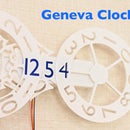Introduction: Monolithic Digital Clock
Easy to make, beautiful digital clock with WiFi time acquisition.
- Monolithic structure : It consists of only one functional part (except rear cover)
- Monolithic appearance : when power is off, it looks like a marble brick
- Automatic time adjustment using NTP via WiFi
- WiFi setting from your smartphone
Supplies
- 25 pixels of WS2812B (a.k.a. Neopixel) LED strip, 60 pixels per meter (16.67mm pitch), not covered by waterproof tubes. I used BTF-LIGHTING product (IP30 Non-Waterproof).
- ESP32 (ESP-WROOM-32) micro computer. The back cover is designed for the short type ESP32 dev board, such as MH-ET LIVE MiniKit for ESP32 or its compatibles.
- four 2 x 10mm tapping screws
- electric wire, soldering iron
- decoration sheet : renovation sticker sheet / wallpaper (woody, marble, cloth, etc.)
Step 1: Print the Monolithic Light Guide
Print the monolithic light guide using your 3D printer.
- Print with supplied posture.
- Support is not necessary to print.
Attachments
Step 2: Prepare LED Strip
- Cut LED strip to 7, 7, 1, 7, 3 (correspond to 1min, 10min, colon, 1hour, 10hour respectively)
- Re-connect LED strips each other with electric wire (5V, GND, Din / Dout)
- Connect LED strips to ESP32 (VCC, GND and GPIO16)
- Check all LEDs lit
Step 3: Stick LED Strip
Stick LED strips to the main body with adhesive tapes.
Step 4: Prepare Rear Cover (optional)
- Print cover.stl with supplied posture. Support is not necessary.
- Insert ESP32 board to the slot.
- Attach rear cover with 4 tapping screws.
Attachments
Step 5: Cover With Diffusive Material
Cover the clock with thin and diffusive material.
I bought some decoration sheet at 1 dollar shop (100yen shop).
- One is natural wooden sheet (very thin real wood sheet with adhesives).
- The other is marble like sticker sheet. Both are sufficiently translucent and diffuse.
- It would be nice to use your favorite photo as diffuser.
- The other idea is to use half mirror with this clock. In this case, stick a copy paper to the whole of backside of the mirror to diffuse the light.
Step 6: Flash Code
Flash code to ESP32 using Arduino IDE.
- Please change the value of TIMEZONE to your living place.
Attachments
Step 7: Configure WiFi
You can configure the WiFi settings of your ESP32 via smartphone app. Use smatConfig.ino as Arduino sketch.
- ESP32 stores SSID and password in its non-volatile memory.
- If previous (memorized) SSID and password do not work, it automatically moves to SmartConfig mode after 30 seconds. The clock shows "SC" (meaning SmartConfig).
Please configure your WiFi using the apps at
Android: https://play.google.com/store/apps/details?id=com.khoazero123.iot_esptouch_demo&hl=ja&gl=US
iOS: https://apps.apple.com/jp/app/espressif-esptouch/id1071176700
Step 8: (Optional) Single Digit Unit
Multi-purpose single digit and colon units (STL files) are also provided.
- You can use them for various projects, such as 24hours clock, subscription counter or huge calculator.
- You can connect multiple units each other with holes on both sides. Not only screws but also zip ties would work.
- Discrete back cover is supplied. The cover for single digit is snap-fit (with hooks). You can use side notches to pass through the cables or zip ties. Back cover for the colon unit has no way to fix, so please use glue.
- For 24hours clock, use smartConfig24H.ino to flash the code




















